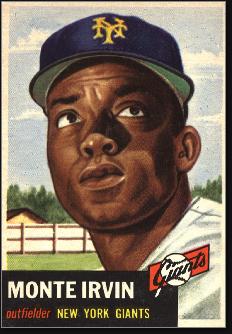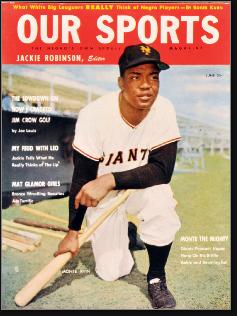
Sport: Baseball
Born: February 25, 1919
Died: January 11, 2016
Town: Orange, New Jersey
Monford Merrill Irvin was born February 25, 1919 in Haleburg, Alabama and grew up in Orange, NJ. One of 13 brothers and sisters, Monte moved north with his family to Orange in the mid-1920s. Among the extended family that made the trip north was his nephew, Harvey Grimsley, who would become a standout football player for Rutgers. Monte’s younger brother, Cal, would play in the Negro Leagues and become a championship basketball coach at North Carolina A&T.
Monte was a standout in baseball, football, basketball and track for East Orange High School, earning four varsity letters in each of his four years. He stood 6’1” and was a rock-solid 190 pounds. He and his classmate, Lennie Pearson, switched off as pitcher and catcher for the baseball team until Pearson injured his arm. The two would later reunite in pro ball. Monte’s size, speed and quickness made him a demon on the football field, and his strong arm enabled him to set a schoolboy record in the javelin throw.
Harry Kipke, the University of Michigan’s legendary coach, wanted Irvin for his backfield. Unfortunately, even with a football scholarship, the Irvins did not have the money to send their son away. Instead, he attended Lincoln University, a historically black college in Pennsylvania. Monte’s plan was to use his football scholarship to earn a degree in dentistry, but when practice started to cut into his study time, he left the school and joined the Newark Eagles at the age of 19.
Two seasons earlier, Monte had played for the club under an assumed name in order to maintain his amateur status. By 1940, however, Monte was the team’s everyday shortstop and best hitter at the age of 21. The club’s centerfielder was Pearson, his battery mate at East Orange High.
In 1941, Monte batted over .400, establishing himself as one of the best players in the Negro Leagues. Heading into 1942, Irvin was expecting a raise. When team owners Abe and Effa Manley turned him down, he accepted an offer to play in the Mexican League, for the Vera Cruz Blues. Despite missing the first quarter of the season, Monte still led the Mexican League in home runs and batting. Meanwhile, Pearson won the triple crown back in Newark. One can only wonder what the Eagles might have accomplished had the Manleys loosened their pursestrings a bit.
Monte was drafted into the army in 1943 and served in the 1313th General Services Engineers, an all-African American unit tasked with infrastructure projects in England and (later) France and Belgium. He served until September 1945 and barely picked up a glove during that time.
Monte returned to Newark in the fall of 1945. He rejoined the Eagles for the tail end of the season and soon discovered that three years with no baseball had dulled his competitive edge. He sharpened his game in the Puerto Rican Winter League and was named MVP. In the spring of 1946, he returned to the Eagles and won the batting championship. That season, Monte teamed with second baseman Larry Doby and star pitcher Leon Day to lead the Eagles to the Negro National League pennant and a seven-game victory over the Kansas City Monarchs in the Negro League World Series.
In 1947, Branch Rickey of the Brooklyn Dodgers showed interest in signing Monte. Because the Negro Leagues were not regarded as part of organized baseball, the Dodgers did not have to respect his contract with the Eagles. The Manleys threatened to sue the Dodgers and Rickey backed off. Monte remained an Eagle for the 1947 and 1948 seasons. With the integration of the Major Leagues, the Negro National League folded and the Eagles went out of business.
In 1949, after Monte led the Cuban Winter League in home runs, the New York Giants signed him. He hit .224 as a 31-year-old “rookie” in limited action. He became a regular in 1950 and, in 1951, led the Giants with a .312 batting average and was the NL leader with 121 runs batted in. He finished third in the MVP voting, behind Roy Campanella and Stan Musial.

The Giants made headlines that year by winning the pennant on Bobby Thomson’s 9th-inning playoff home run against the Brooklyn Dodgers. Two days later, Monte joined Willie Mays and Hank Thompson in Game 1 of the World Series to form the first all-black outfield in postseason history. Monte batted .458 in the series against the Yankees, but the Giants fell, 4 games to 2.
Monte played four more years with the Giants. During that time, he served as a mentor to Mays, and also helped the Giants win the 1954 World Series. During the 1955 season, the Giants sent Monte to the minors. The Chicago Cubs snapped him up in 1956 and he hit 15 homers and batted .271 in his final big-league season. He hung up his spikes after injuring his back during spring training with the minor-league Los Angeles Angels in 1957.
Monte returned to the Garden State and secured a community relations job with Rheingold Beer, a favorite of blue-collar fans, both white and black. Rheingold was one of the Mets’ first sponsors when NL baseball returned to New York in 1962. Monte developed a close relationship with the club and, in 1967, left Rheingold to scout for the Mets. In 1968, he was hired by Major League Baseball as a public relations specialists, making him MLB’s first African-American executive. He retired as a fulltime executive in 1984, but continued to work on special projects for MLB.
Monte was inducted into the Hall of Fame in 1973, voted in by a special committee for his exploits as a Negro Leaguer. In 2010, the Giants retired his number 20 and, that fall, he threw out the first pitch before one of the team’s World Series games. He passed away in 2016 at the age of 96 in Houston.
Monte’s big-league numbers were 99 homers, 443 RBIs and a .293 average in 764 games—all achieved in his declining years as an athlete. In 2022, his Negro League stats were officially recognized, boosting his career totals to 137, 687 and .305.
What might his record look like had the playing field been even when he entered the game? Most experts put him in the same class statistically with players like Al Kaline, Billy Williams and Jim Rice. But everyone who knew Monte Irvin knew that was only half the answer. He was truly in a class by himself.